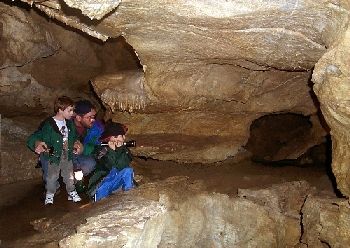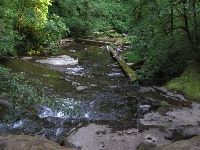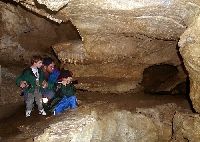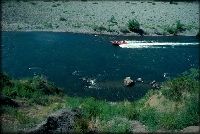
Publisher:
Bonnie King
CONTACT:
Newsroom@Salem-news.com
Advertising:
Adsales@Salem-news.com

~Truth~
~Justice~
~Peace~
TJP
Jun-16-2009 16:17

 TweetFollow @OregonNews
TweetFollow @OregonNews
DeFazio, Wyden Introduce Legislation to Protect Several Oregon Landmarks
Salem-News.comThe House Natural Resources Committee and the Senate Energy Committee are expected to hold a hearing on these bills in the near future.
 Photos, Oregon Caves: City of Grants Pass Devils Staircase: devilsstaircasewilderness.org/ Lower Rogue River: U.S. Forestry Service |
(WASHINGTON, D.C.) - Rep. Peter DeFazio and Sen. Ron Wyden today introduced three pieces of legislation to protect some of Oregon’s most wild places; Devil’s Staircase, Oregon Caves and the Lower Rogue River. DeFazio and Wyden have worked extensively on these important pieces of legislation with input from the public and private stakeholders.
The Devil’s Staircase legislation designates approximately 29,650 acres of the Siuslaw National Forest as a wilderness area. The Oregon Caves bill adds approximately 4,070 acres to the Oregon Caves National Monument and the Lower Rogue Wild and Scenic bill designates 142.9 miles of 40 waterways as “wild,” “scenic,” or “recreational”.
“Our beautiful state has so many places that are worthy of congressional recognition. Devil’s Staircase alone is a phenomenally beautiful and rugged area full of old growth and rare species such as the giant tree lizard, marbled murrelet, and spotted owl” said Congressman DeFazio.
“I am thrilled to be able to work with Oregon’s Senators to bring protection to some of Oregon’s wildest and most beautiful treasures. From the tributaries of the Wild Rogue, to the Cave Creek watershed, to the stunning and remote Devil’s Staircase, we have an historic opportunity to leave a natural legacy for future generations.”
“The Rogue River, Devil’s Staircase and the Oregon Caves are fantastic examples of Oregon’s beauty and natural diversity," said Wyden. "We are going to make certain they are protected appropriately for future generations.”
Devil's Staircase

The legislation would protect the wilderness area situated between the Smith and Umpqua Rivers in the heart of Oregon’s coastal rainforest. This measure will be vital to protecting some of the last old growth in Oregon’s Coastal Range and the endangered species sustained by old growth forests.
Devil’s Staircase takes its name from a series of awe-inspiring sandstone waterfalls in the heart of the proposed wilderness area on Wasson Creek.
The 29,650 acres is blanketed in douglas fir, cedar, and hemlock and encompasses the last remaining old-growth forest in Oregon’s Coastal Range. The Devil’s Staircase area is an historic remnant of what the Oregon Coast Range once looked like.
The Devil’s Staircase area was proposed for wilderness under the 1984 Oregon Wilderness Act by former Rep. Jim Weaver (D-OR), but was stripped out at the last minute for an area more imminently threatened.
The forest soils of the proposed wilderness area are classified as the most landslide-prone soil type in Oregon and among the most unstable in the world. In fact, unstable soils were so problematic that early efforts to log in the vicinity of Devil’s Staircase that, in the 1970s, the U.S. Forest Service withdrew from timber management all land between the Smith and Umpqua rivers.
The wilderness includes Wasson Creek which supports native coho and chinook salmon, trout, and steelhead runs. Black bears, elk, deer, river otter, spotted owls, and marbled murrelets live as they have for thousands of years sequestered in this remnant of Oregon's coastal forest. With the highest density of northern spotted owls in the Coast Range, Wasson Creek is critical to the recovery of this threatened species.
The Legislation:
* Designates approximately 29,650 acres of the Siuslaw National Forest as a wilderness area.
* Protects 14.4 miles of the Wasson and Franklin creeks.
Oregon Caves

The legislation would enhance the protection of the natural resources associated with Oregon Caves National Monument, increase public recreation opportunities, expand local economic development opportunities, and protect the drinking water source of Oregon Caves National Monument from pollution and contamination by adjusting the boundary of the Monument.
President Taft created the Monument by Proclamation 876 on July 12, 1909. It is currently 480 (three-quarters of a square mile) acres and encompasses only the mouth of the High Hopes, Monument Deep, Oregon, and Clay Caves.
The Oregon Caves Chateau is located near the caves, and is one of the National Park system’s Great Lodges and a National Historic Landmark. The six-story hotel located on the monument has a fine dining room, a 1930’s era coffee shop, and 23 rooms.
Oregon Caves is the longest marble cave (3.5 miles) open to the public west of the Continental Divide
According to the city of Cave Junction, the economic development strategy of the Illinois Valley is tourism, and the Oregon Caves is the largest tourist draw in the area. Similarly, the Grants Pass Chamber of Commerce notes that over 25,000 visitors pass through the Grants Pass visitors center each year, with many of them headed to the Oregon Caves.
Recent discoveries indicate that Oregon Caves possesses a significant collection of Pleistocene fossils, including jaguar and grizzly bear. Grizzly bones that were found in the cave in 1995 were estimated to be at least 50,000 years old, the oldest known from either North or South America.
The Monument is managed by the National Park Service; the surrounding watershed is managed by the Forest Service (Rogue River-Siskiyou National Forest) Grazing in the watershed has caused water quality problems, including contamination of the Monument’s drinking water supply.
The NPS has formally proposed to expand the boundary of the Monument to encompass several other caves, as well as the surrounding Cave Creek Watershed numerous times, first in 1939, again in 1949, and most recently in 2000
The legislation:
* Adds approximately 4,070 acres to the Monument by transferring the land from the Forest Service to the National Park Service and designates the land as a National Preserve;
* Designates 7.6 miles of 6 waterways as “wild,” “scenic,” or “recreational” under the Wild and Scenic Rivers Act, including the first subterranean designated waterway in the country, the River Styx, which flows through the Caves;
* Encourages ecological forest restoration; and
* Permits the donation of grazing permits and leases associated with the expanded boundary.
Lower rogue wild and scenic river additions

Pursuant to the Wild and Scenic Rivers Act, the legislation would designate 142.9 miles of tributaries to the Rogue Wild and Scenic River (est. 1968) and classify the tributaries as either “Wild,” “Scenic,” or “Recreational” in order to protect the outstandingly remarkable values of these tributaries themselves as well as the benefits that these tributaries contribute to the Lower Rogue Wild and Scenic River.
In 1968, Congress protected 84 miles of the lower Rogue River under the Wild and Scenic Rivers Act due to the River’s “outstandingly remarkable values” of high water quality, excellent fishery, and recreational opportunities. The Rogue was one of the first rivers protected under the Act.
The headwaters of the Rogue River are in Crater Lake National Park, and ultimately empty into the Pacific Ocean near Gold Beach on the southwestern Oregon coast, 215 miles away.
The Rogue River is Oregon’s second largest producer of salmon, largely due to the clear, cold water the river’s tributaries provide to the main stem of the Rogue.
The Rogue River is home to runs of coho, spring and fall chinook, winter and summer steelhead, as well as being one of only a few rivers in the country with runs of green sturgeon. Rogue River tributaries provide spawning and rearing habitat for winter and summer steelhead and coho salmon.
Recreation is the largest source of economic stimulus for the communities of southern Oregon, which supports dozens of outfitters, guides, and associated businesses. The Bureau of Land Management estimates that more than 25,000 people use the Rogue River every year, which generates more than $13 million dollars annually.
The famed adventure writer Zane Grey spent much of his time in the heart of Rogue River country. He owned a small cabin at Winkle Bar on the Rogue where he wrote many of his celebrated books, including Rogue River Feud and Tales of Freshwater Fishing. The cabin still stands today, and is a popular attraction for river visitors.
A large roadless area that surrounds the Rogue and its tributaries, the Zane Grey roadless area, is named after the writer.
The legislation:
* Designates 142.9 miles of 40 waterways as “wild,” “scenic,” or “recreational” under the Wild and Scenic Rivers Act; and
* Consistent with the Act, creates a half-mile wide buffer of protection on both sides of the waterway.
The House Natural Resources Committee and the Senate Energy Committee are expected to hold a hearing on these bills in the near future.
Source: DeFazio / Wyden news release
Articles for June 15, 2009 | Articles for June 16, 2009 | Articles for June 17, 2009






Terms of Service | Privacy Policy
All comments and messages are approved by people and self promotional links or unacceptable comments are denied.
[Return to Top]
©2025 Salem-News.com. All opinions expressed in this article are those of the author and do not necessarily reflect those of Salem-News.com.